In math ascending order or descending order kids will learn to arrange the numbers from bigger to smaller number and also from smaller to bigger number.
Arranging in order:
Arranging the following from small to big.
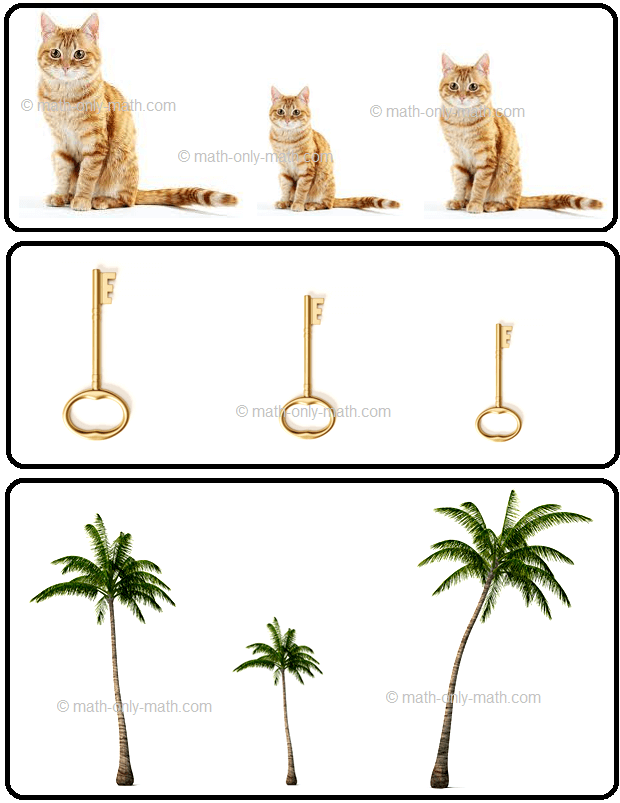
Small to Big:
Arrange the numbers from small to big. One is done for you.
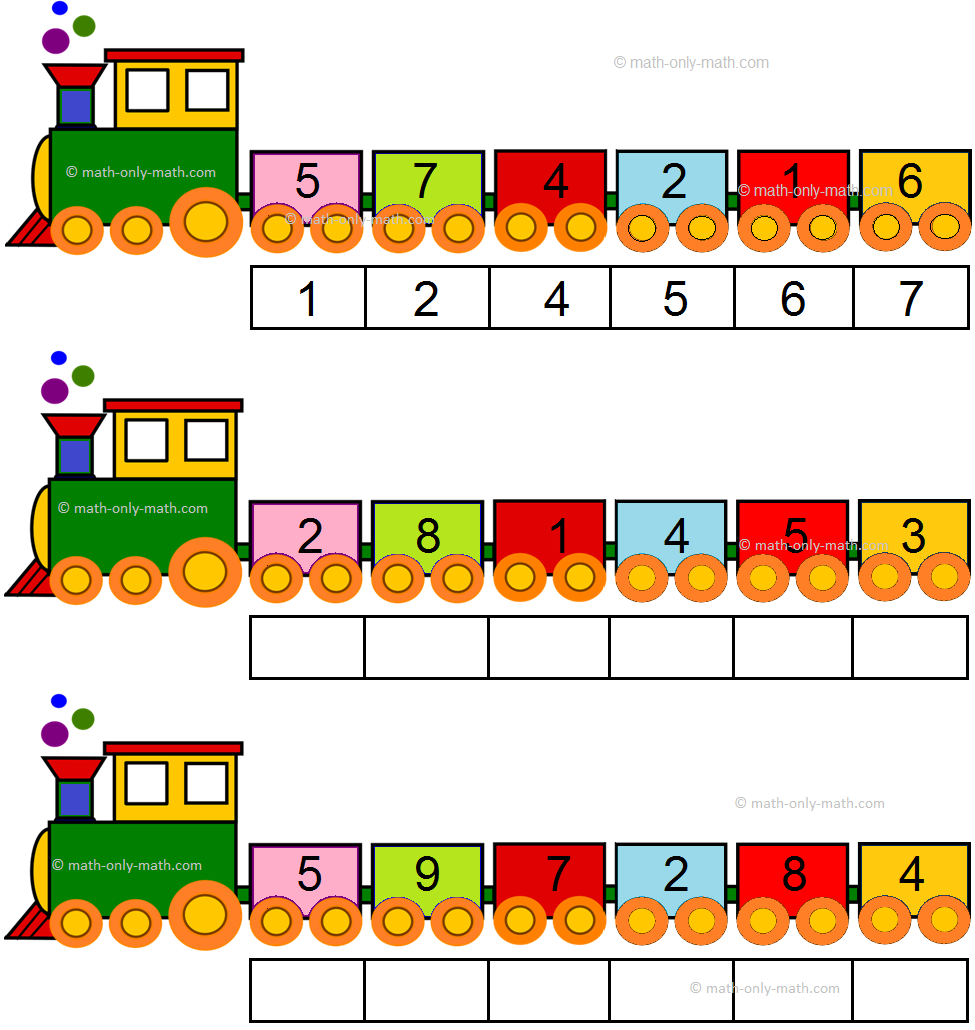
Ascending Order:
When the numbers are arranged from the smallest to the largest number, those numbers are said to be in an ascending order.
For example:
1. Arrange the numbers in ascending order from 5 to 11.
5, 6, 7, 8, 9, 10, 11
[the numbers are arranged from the smallest to the largest number]
2. Arrange the following numbers in ascending order:
(i) 14, 78, 56, 44
(ii) 63, 32, 45, 60
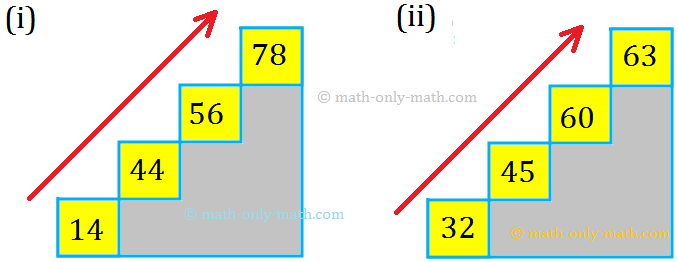
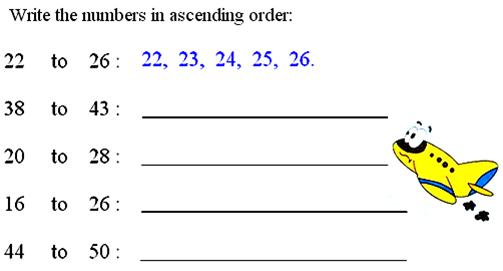
Arranging in order:
Arranging the following from big to small.
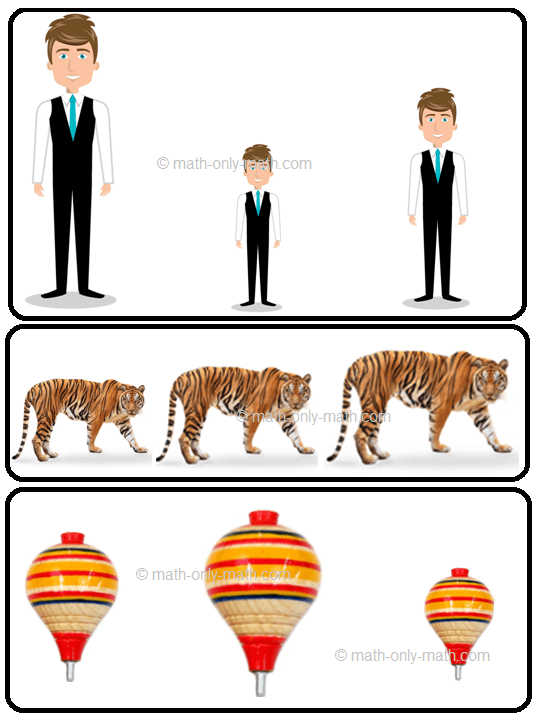
Big to Small:
Arrange the numbers from big to small. One is done for you.
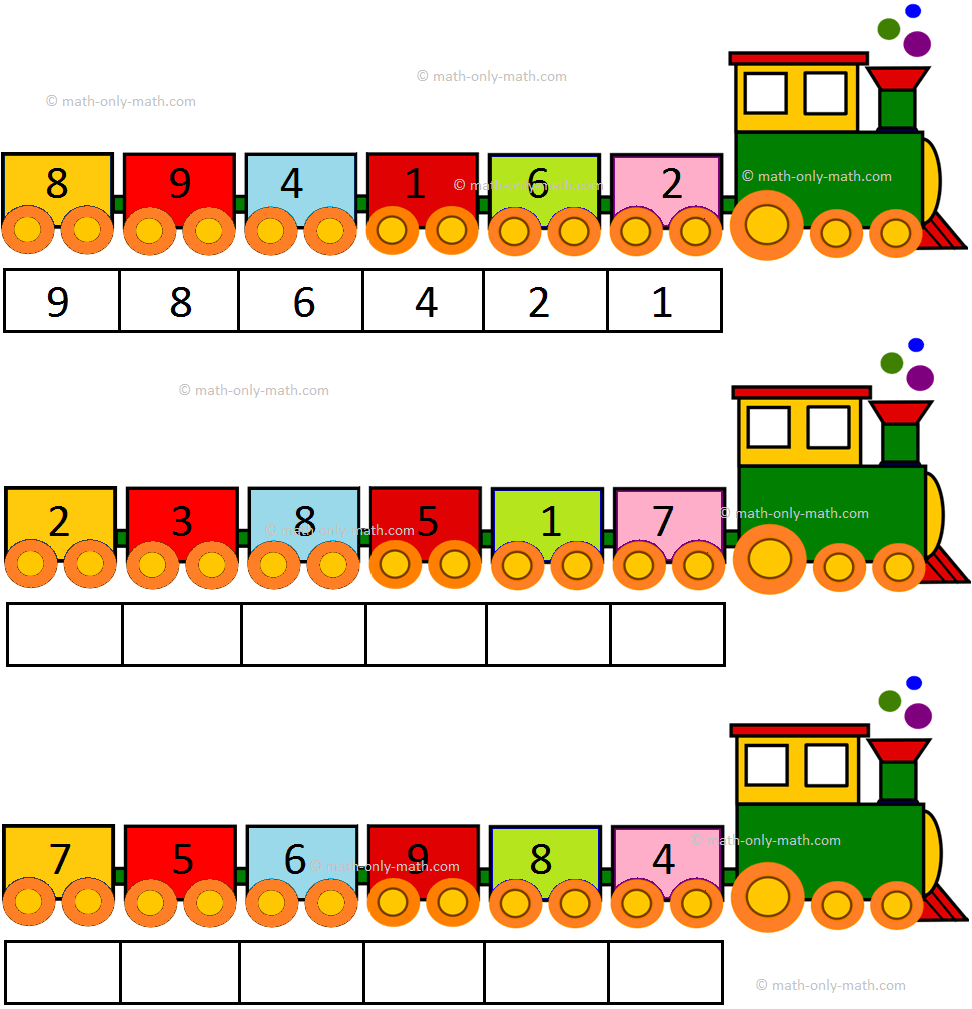
Descending Order:
When the numbers are arranged from the largest to the smallest number, those numbers are said to be in descending order.
For example:
1. Arrange the numbers in descending order from 23 to 17.
23, 22, 21, 20, 19, 18, 17
[the numbers are arranged from the largest to the smallest number]
2. Arrange the following numbers in descending order:
(i) 24, 84, 19, 65
(ii) 50, 20, 60, 70
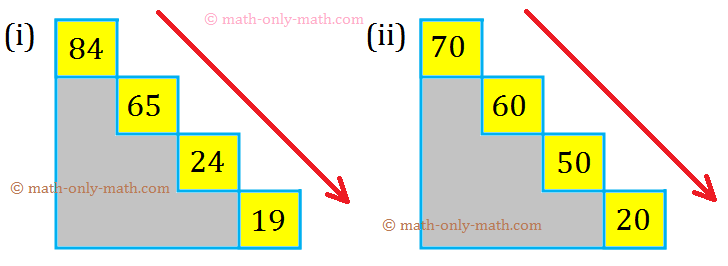
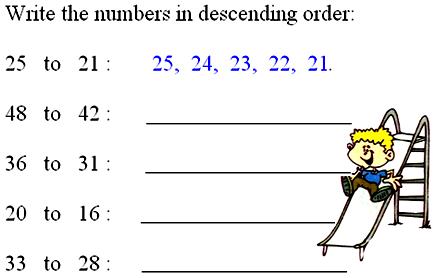
NUMBER IN ORDER:
Let us write the number 312, 202, 162 and 455 in ascending order and the numbers 416, 326, 980 and 243 in descending order.
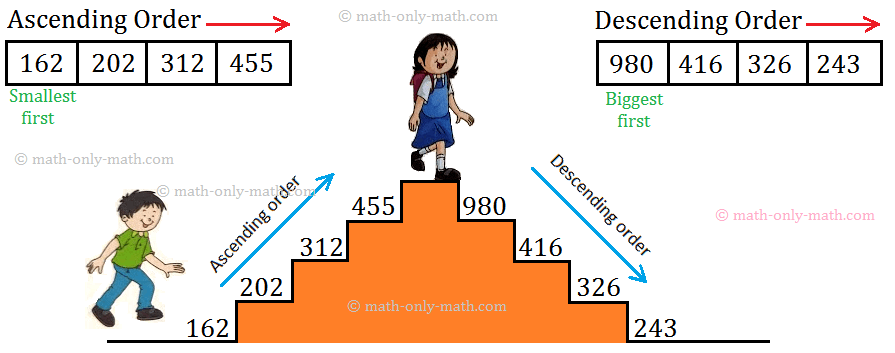
Worksheet on Ascending Order or Descending Order:
1. Arrange the given numbers in ascending order.
(i) 25, 22, 39, 36, 52
(ii) 85, 91, 36, 29, 44
Answer:
1. (i) 22, 25, 36, 39, 52
(ii) 29, 36, 44, 85, 91
2. Arrange the given numbers in descending order.
(i) 65, 88, 74, 35, 5
(ii) 27, 45, 8, 31, 75
Answer:
2. (i) 88, 74, 65, 35, 5
(ii) 75, 45, 31, 27, 8
3. Arrange the following numbers in ascending order:
(i) 26, 32, 62, 13, 40
(ii) 28, 82, 42, 99, 95
(iii) 77, 66, 55, 32, 44
(iv) 63, 72, 55, 42, 95
(v) 14, 28, 41, 80, 15
Answer:
3. (i) 13, 26, 32, 40, 62
(ii) 28, 42, 82, 95, 99
(iii) 32, 44, 55, 66, 77
(iv) 42, 55, 63, 72, 95
(v) 14, 15, 28, 41, 80
4. Arrange the following numbers in descending order:
(i) 30, 10, 9, 50, 19
(ii) 19, 21, 60, 40, 22
(iii) 44, 96, 29, 79, 73
(iv) 32, 40, 31, 49, 75
(v) 41, 14, 20, 50, 36
Answer:
4. (i) 50, 30, 19, 10, 9
(ii) 60, 40, 22, 21, 19
(iii) 96, 79, 73, 44, 29
(iv) 75, 49, 40, 32, 31
(v) 50, 41, 36, 20, 14
5. Arrange the numbers in ascending and descending orders.
|
Ascending Order |
Descending Order |
|
|
(i) 76, 10, 39, 54 (ii) 65, 37, 74, 12 (iii) 33, 52, 46, 64 |
___ ___ ___ ___ ___ ___ ___ ___ ___ ___ ___ ___ |
___ ___ ___ ___ ___ ___ ___ ___ ___ ___ ___ ___ |
Answer:
5. (i) Ascending Order: 10, 39, 54, 76
Descending Order: 76, 54, 39, 10
(ii) Ascending Order: 12, 37, 65, 74
Descending Order: 74, 65, 37, 12
(iii) Ascending Order: 64, 52, 46, 33
Descending Order: 33, 46, 52, 64
6. In the national park in X, Y and Z numbers of deers found are 126, 182 and 202. Arrange the cities in ascending order for the population of deers.
Answer:
6. X, Y, Z
Ascending Order up to 50
7. Arrange the numbers in ascending order. One has been done for you.
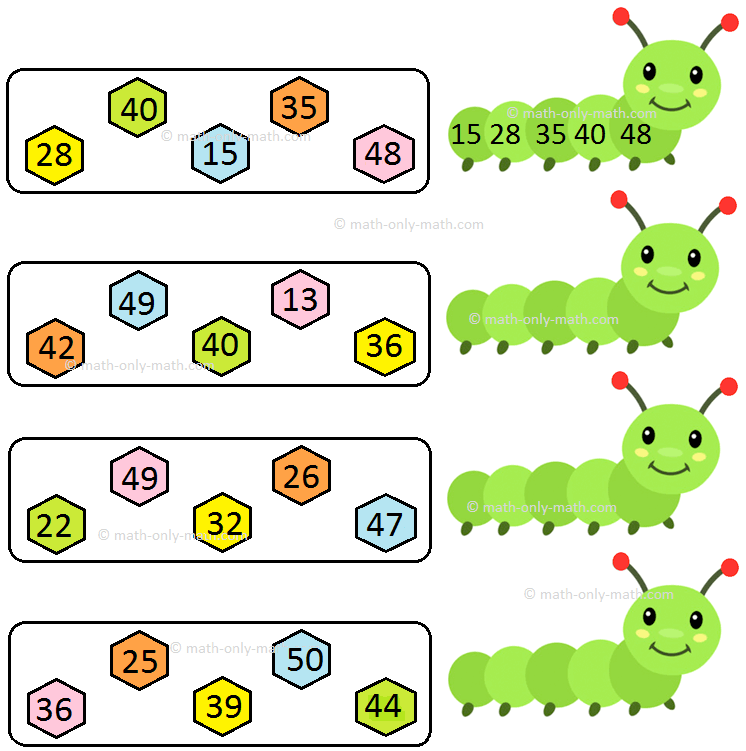
Answer:
7. (ii) 13, 36, 40, 42, 49
(iii) 22, 26, 32, 47, 49
(iv) 25, 36, 39, 44, 50
Descending Order up to 50
8. Arrange the numbers in descending order. One has been done for you.
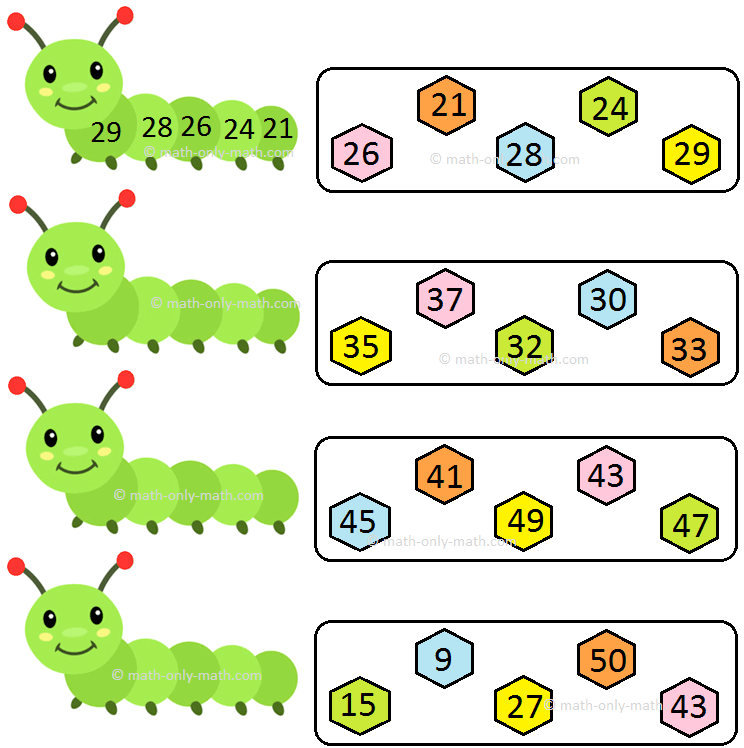
Answer:
8. (ii) 37, 35, 33, 32, 30
(iii) 49, 47, 45, 43, 41
(iv) 50, 43, 27, 15, 9
9. Arrange the numbers in ascending and descending orders.
(i) 595 321 462 325
Ascending order: ___ ___ ___ ___
Descending order: ___ ___ ___ ___
(ii) 923 538 438 548
Ascending order: ___ ___ ___ ___
Descending order: ___ ___ ___ ___
(iii) 148 594 487 689
Ascending order: ___ ___ ___ ___
Descending order: ___ ___ ___ ___
(iv) 646 123 316 291
Ascending order: ___ ___ ___ ___
Descending order: ___ ___ ___ ___
(v) 899 501 654 844
Ascending order: ___ ___ ___ ___
Descending order: ___ ___ ___ ___
Answer:
9. (i) Ascending order: 321, 325, 462, 595
Descending order: 595, 462, 325, 321
(ii) Ascending order: 438, 538, 548, 923
Descending order: 923, 548, 538, 438
(iii) Ascending order: 148, 487, 594, 689
Descending order: 689, 594, 487, 148
(iv) Ascending order: 123, 291, 316, 646
Descending order: 646, 316, 291, 123
(v) Ascending order: 501, 654, 844, 899
Descending order: 899, 844, 654, 501
Parent and teachers are requested to take the print-out of this worksheet on ascending order or descending order so that children can practice arranging the numbers. Before practicing this worksheet kids need to read the above lines, understand and then quickly grab a pencil to enjoy arranging the numbers. If the children is a visual learner they can also follow the direction of the colorful picture to understand it in math logical way.
Answer:
Numbers are arranged from the smallest to the greatest in increasing order and from the greatest to the smallest in decreasing order. Increasing order is also called ascending order and decreasing order is also called descending order.
Answer:
Identify and write the smallest number first. → 17
Identify and write the smallest number among the remaining, that is, 47, 63 and 88. → 47
Identify and write the smaller of the remaining two, that is, 63 and 88. → 63
The last number left is 88. Write it. → 88
Ascending order: 17 < 47 < 63 < 88.
Answer:
Let us Identify and write the greatest number first. → 92
Identify and write the greatest number among the remaining, that is, 29, 40 and 21. → 40
Identify and write the greater of the remaining two, that is, 29 and 21. → 29
The last number left is 21. Write it. → 21
Descending order: 92 > 40 > 29 > 21.
Numbers
– Worksheet
Missing Numbers Worksheet
Worksheet on Tens and Ones
Number Dot to Dot
Before and After
Number that Comes Between
Greater or Less than and Equal to
Ascending Order or Descending Order
Number
Games
First Grade Math Activities
From Ascending Order or Descending Order to HOME PAGE
Didn’t find what you were looking for? Or want to know more information
about Math Only Math.
Use this Google Search to find what you need.
